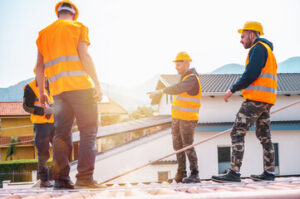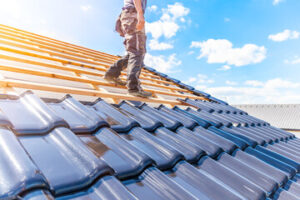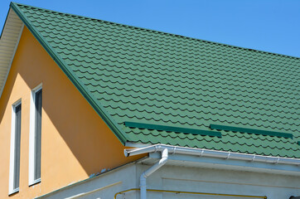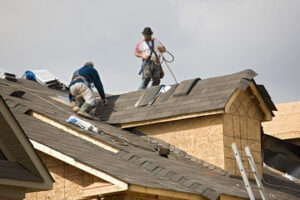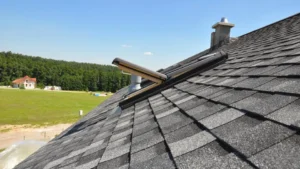While tile roofs are durable and attractive, they’re not invincible. Strong winds and extreme weather conditions can damage them, and if there’s severe water damage or structural issues, replacement is the best option.
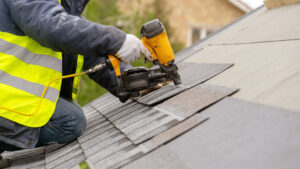
Repair is less expensive than a complete roof replacement, but it’s also limited in scope. It involves working on a small, isolated area to fix an issue. Visit https://roofersjacksonvillefl.co/ to learn more.
When shingles or tiles become damaged, it is important to repair them promptly. This will prevent water leaks and other problems from forming. A professional roofer can do this quickly and efficiently. They will also ensure that the new shingle or tile matches the rest of the roofing material. This will protect the entire roof and help it last longer.
Missing shingles can leave the interior of your roof exposed to sun or rain, leading to mold, rot and other problems. The first step in repairing this is to determine how many are missing. This will give the roofer an idea of how many to replace. They may need to loosen the nails on a nearby shingle to inspect for additional damage.
If there are only a few missing, it may be possible to simply replace them with new shingles. However, this can be difficult if the damaged shingles are on a highly visible section of the roof. The new shingles will need to be matched to the color and profile of the existing shingles, which can be challenging.
Cracks in shingles are more problematic, as the cracks will allow water into the internal roof spaces. These leaks will eventually lead to rot and other serious structural problems. Using wood glue, caulk or putty to seal these cracks will be more effective than replacing the cracked shingles.
Blistering is another common shingle problem. This occurs when the shingle is exposed to excessive heat or UV rays, which can cause the granules to separate from the shingle. This can also happen due to age, which is why it is important to replace a damaged shingle immediately.
Bruising is a more serious issue that can be caused by being pelted with solid objects at high speeds, such as hail, rocks or debris. This type of shingle damage is more serious than cracks or punctures and can be recognized by the round, concave dent in the center of the shingle.
A roofer will use a pry bar to gently lift the damaged shingle to break the seal and gain access to the nails holding it in place. They will then remove the old shingle and install a new one, making sure to match it as closely as possible to the existing shingles. They will also apply a waterproof sealant to the area.
Water Leaks
A roof leak is the most common cause of water damage in a home. It can lead to stains on ceilings, drywall, carpet, and furniture. It can also create health problems, such as mold and mildew. It can also destroy insulation and decrease the value of your home.
It is important to regularly check for leaks and have them fixed as soon as possible. A small leak can become much larger if left untreated. Depending on the amount of water entering your home, it may be necessary to install new flooring, walls, and even entire rooms.
Leaks are usually caused by damaged shingles or flashing. A damaged shingle can allow water to seep under the shingle and into the attic or crawl space. Depending on the size of the hole, it may be necessary to replace the shingle or use a temporary patch.
A leaking roof can also be caused by clogged gutters, particularly in valleys. A valley is where two sloping roofs meet and can be easily clogged with leaves and debris. It is important to keep the gutters clear of debris to prevent this from happening.
Another common reason for a leaking roof is deteriorated flashings, such as around chimneys, skylights, or vent pipes. It is important to regularly inspect the flashing and replace it if needed.
The easiest way to make a temporary repair is to place a tarp over the affected area. This will provide protection until help can arrive. If you are unsure how to do this, it is a good idea to contact a professional.
It is also a good idea to remove any insulation near the leak and clean the area. Once the tarp has been placed, it is important to regularly inspect it for any areas where the shingles have lifted or shifted. If you notice any, then it is a good idea to contact Roofing Washington to fix the problem as quickly as possible to avoid further damage to your property. In addition, it is a good idea to have a tarp ready in case of any unexpected rainy weather.
Damage to the Substrate
Occasionally, roof damage goes beyond the shingles and into the structure itself. This could be due to a severe storm, an animal or simply the aging of the roof over time. When this happens, an emergency repair is needed to prevent the situation from worsening.
Some of the most common structural issues that require rapid repair are problems with the fascia, soffit or plywood decking. These parts of the roof help connect it to rafters, which in turn support the entire roof. When these structures are damaged, it can put the rest of your home at risk of water leaks.
Other causes of this type of roof damage include poor installation, excessive UV exposure and general wear and tear. Some of these problems can be addressed during preventative repairs, while others may necessitate a complete roof replacement.
Structural Damage
If you are a homeowner, it is not uncommon to experience structural problems with your home. It could be anything from a sagging roof to a cracked foundation, and it is a big cause for concern as these problems can affect the integrity of the entire house. Structural damage is more serious and usually costs more to fix than smaller repairs such as a leaky pipe or a broken window frame.
These structural issues can be caused by many different things, including the age of your home and its location. It could also be a result of poor building design, construction defects, or even natural disasters like earthquakes. Whatever the reason, these structural problems are very stressful to deal with and should be dealt with quickly to minimize the damage.
When deciding whether to repair or restore a roof, facilities professionals must consider the extent of the damage, the location of the damage, and the timing and weather. If the damage is limited to a small area of the roof and can be fixed by roof restoration, then it is worth the effort as it will be cheaper than replacing the whole roof.
However, if the damage is extensive and can’t be fixed by roof restoration, then it is time to consider replacing your roof. This is especially true if the damaged areas of your roof are in the most critical locations of your home, such as around chimneys and skylights.
A professional structural engineer will be able to help you decide what is best for your home and what kind of structural repairs are necessary. They will also be able to provide you with detailed, step-by-step procedures and timelines so that you can understand what the work involves.
Having a professional engineer handle your roof repair will ensure that the job is done correctly and to your satisfaction. It will also save you a lot of stress, as you won’t have to worry about doing the repair yourself or hiring someone who might make mistakes that cost you more money in the long run.

